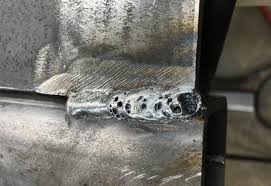What is Porosity in Welding: Comprehending Its Reasons and Enhancing Your Skills
What is Porosity in Welding: Comprehending Its Reasons and Enhancing Your Skills
Blog Article
Unwinding the Mystery of Porosity in Welding: Tips for Reducing Issues and Taking Full Advantage Of Quality
In the intricate world of welding, porosity continues to be a consistent obstacle that can considerably impact the quality and integrity of welded joints. Understanding the aspects that add to porosity development is important in the quest of remarkable welds. By deciphering the secret of porosity and carrying out reliable strategies for issue minimization, welders can elevate the standards of their work to achieve premium quality results. As we look into the depths of porosity in welding, uncovering the keys to its avoidance and control will certainly be vital for professionals seeking to grasp the art of top notch weldments.
Recognizing Porosity in Welding
Porosity in welding, an usual problem run into by welders, describes the presence of gas pockets or gaps in the welded material, which can compromise the honesty and high quality of the weld. These gas pockets are usually entraped during the welding procedure as a result of different aspects such as improper securing gas, contaminated base materials, or incorrect welding criteria. The development of porosity can weaken the weld, making it at risk to cracking and corrosion, eventually bring about architectural failings.
Understanding the origin creates of porosity is critical for welders to efficiently prevent its event. By acknowledging the importance of preserving proper gas securing, making sure the cleanliness of base products, and maximizing welding settings, welders can substantially decrease the chance of porosity formation. Additionally, using methods like preheating the base product, using appropriate welding methods, and conducting comprehensive assessments post-welding can even more aid in reducing porosity flaws. In general, a thorough understanding of porosity in welding is crucial for welders to create top notch and durable welds.

Common Root Causes Of Porosity
When examining welding procedures for possible high quality concerns, understanding the usual reasons of porosity is important for keeping weld integrity and preventing architectural failings. Porosity, defined by the presence of dental caries or voids in the weld metal, can substantially endanger the mechanical residential or commercial properties of a bonded joint.
An additional widespread reason of porosity is the visibility of moisture and pollutants on the surface of the base metal or filler product. When welding materials are not properly cleaned or are exposed to high degrees of humidity, the vaporization of these contaminants during welding can create gaps within the weld bead. Furthermore, welding at incorrect specifications, such as excessively high travel speeds or currents, can create excessive disturbance in the weld swimming pool, trapping gases and triggering porosity. By attending to these common causes through proper gas shielding, material prep work, and adherence to ideal welding specifications, welders can lessen porosity and enhance the top quality of their welds.
Strategies for Porosity Prevention
Carrying out effective safety nets is critical in decreasing the occurrence of porosity in welding procedures. One strategy for porosity prevention is making sure correct cleansing of the base steel before welding. Pollutants such as oil, oil, corrosion, and paint can lead to porosity, so thorough cleansing making use of suitable solvents or mechanical methods is important.

Making use of premium filler materials and shielding gases that are suitable for the base metal and welding process can try here considerably minimize the threat of porosity. Additionally, maintaining appropriate welding parameters, such as voltage, existing, take a trip rate, and gas flow great post to read price, is essential for porosity avoidance.
Additionally, utilizing correct welding techniques, such as preserving a regular traveling rate, electrode angle, and arc length, can help protect against porosity (What is Porosity). Adequate training of welders to ensure they follow finest methods and quality control procedures is also essential in minimizing porosity defects in welding

Best Practices for High Quality Welds
One trick technique is maintaining proper cleanliness in the welding location. Completely cleaning the workpiece and surrounding location prior to welding can help reduce these issues.
Another best method is to very carefully choose the appropriate welding specifications for the certain products being joined. Correct criterion selection makes certain optimum weld infiltration, fusion, and total high quality. Making use of top notch welding consumables, such as electrodes and filler steels, can dramatically affect the last weld quality.
Value of Porosity Control
Porosity control plays a critical role in making certain the integrity and high quality of welding joints. Porosity, identified by the presence of cavities or gaps within the weld metal, can considerably endanger the mechanical residential properties and architectural integrity of the weld. Excessive porosity weakens the weld, making it much more susceptible to breaking, rust, and general failing under operational loads.
Reliable porosity control is essential for maintaining the desired mechanical residential properties, such as stamina, ductility, and toughness, of the bonded joint. What is Porosity. By minimizing porosity, welders can boost the general quality and dependability of the weld, making certain that it fulfills the efficiency needs of the designated application
Additionally, porosity control is vital for attaining the desired aesthetic look of the weld. Excessive porosity not just weakens the weld yet also diminishes its aesthetic charm, which can be important in markets where visual appeals are necessary. Proper porosity control methods, such as making use of the appropriate securing gas, managing the welding specifications, and making certain appropriate tidiness of the base materials, are essential for producing premium welds with minimal problems.

Final Thought
In conclusion, porosity in welding is an usual problem that can endanger the high quality of the weld. It is necessary to manage porosity in welding to additional hints guarantee the honesty and toughness of the final item.
Report this page